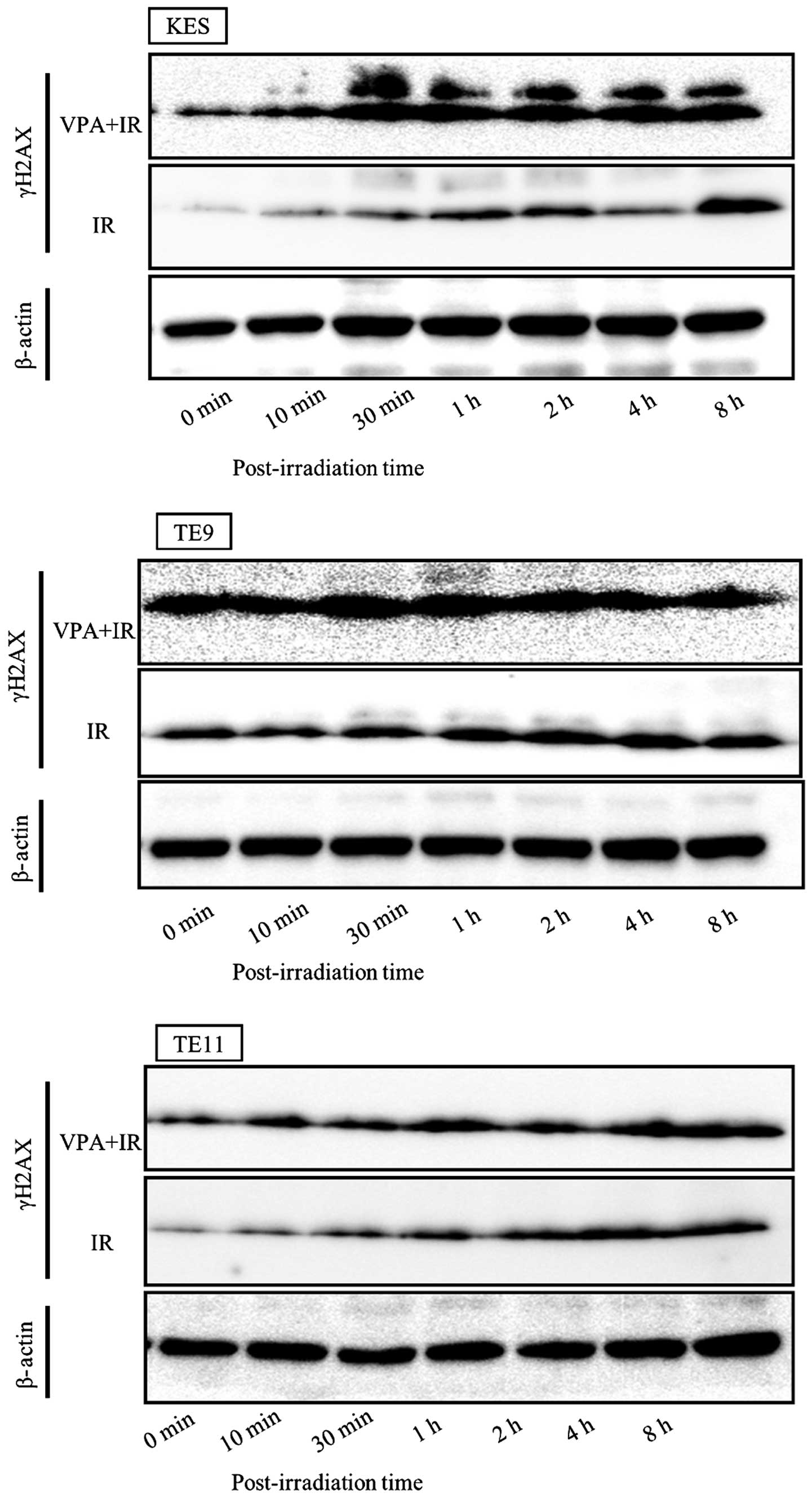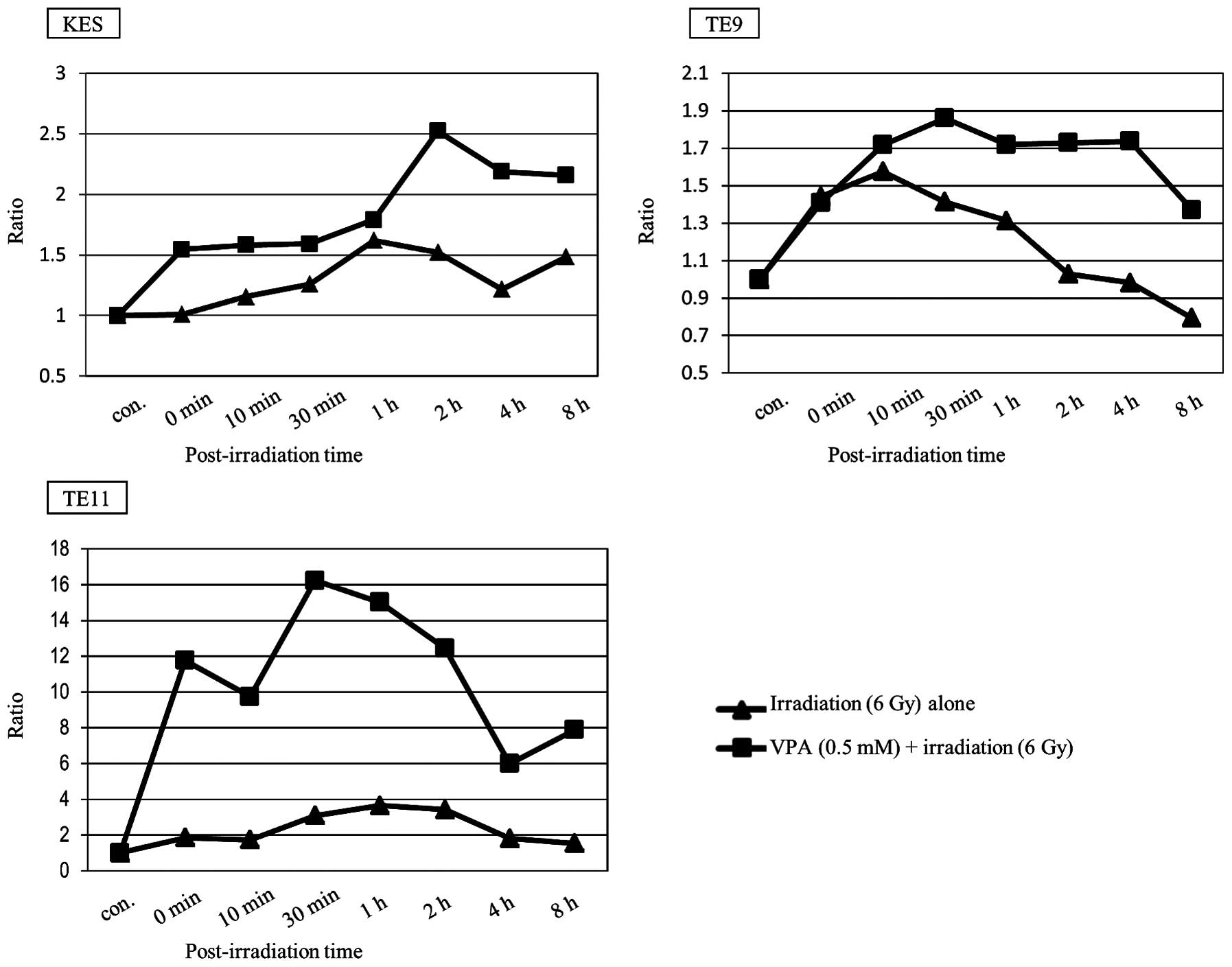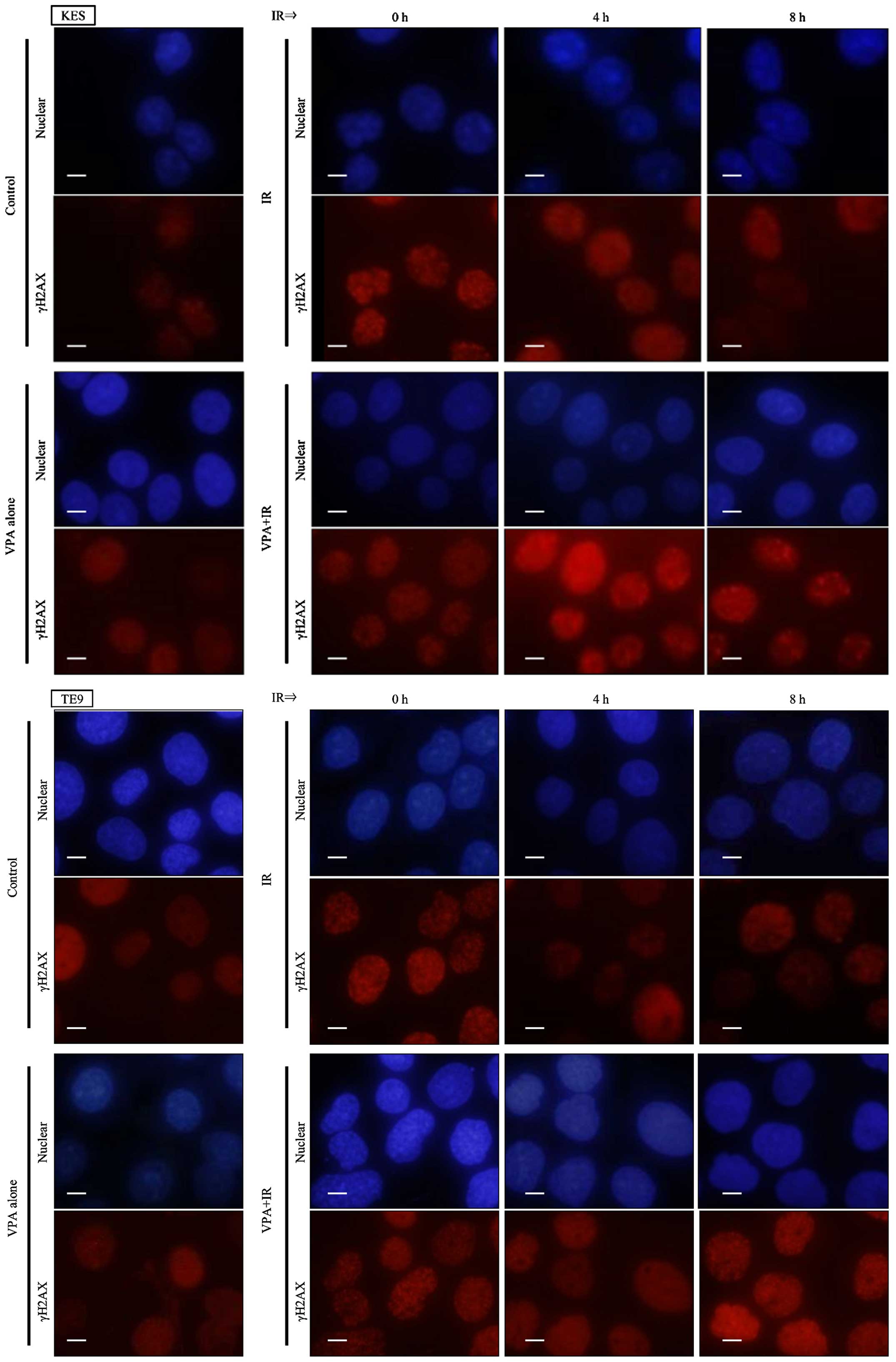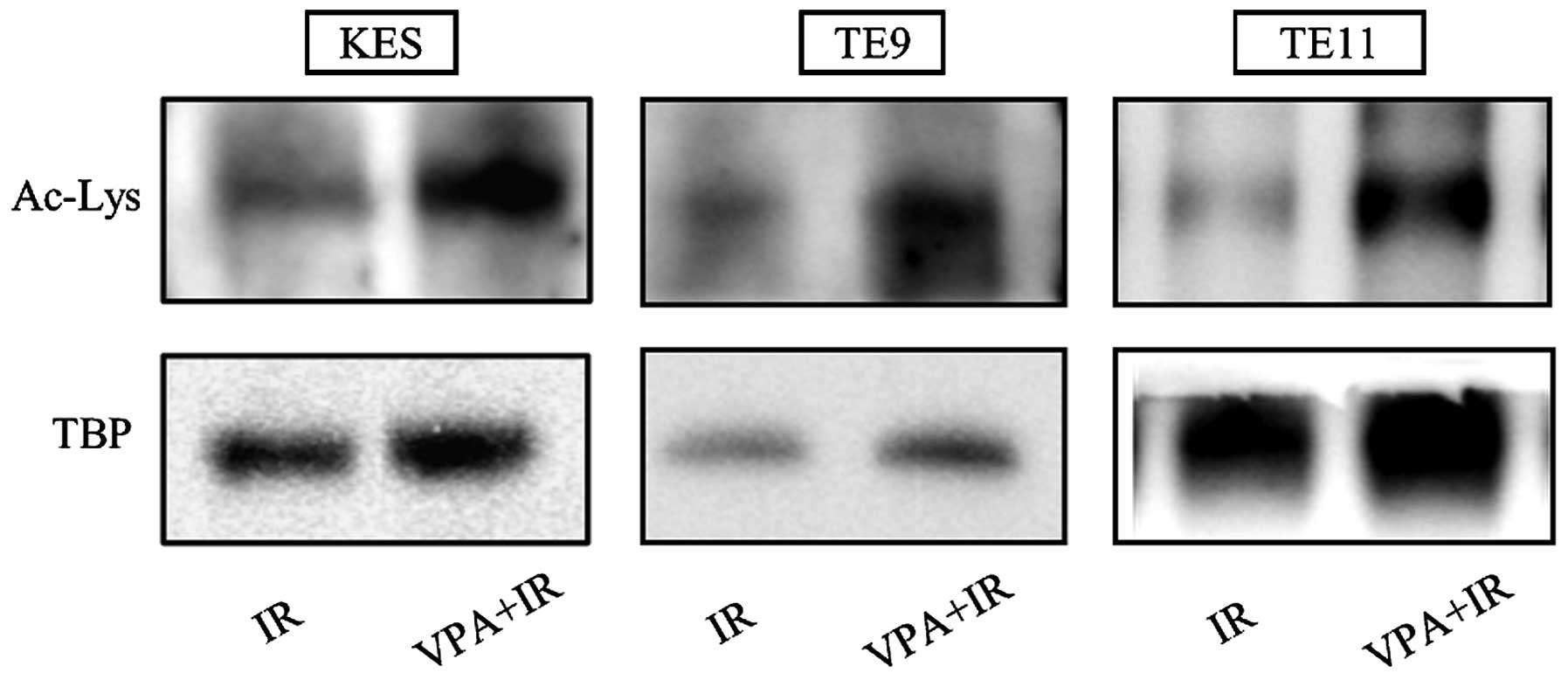|
1
|
Herskovic A, Martz K, al-Sarraf M,
Leichman L, Brindle J, Vaitkevicius V, Cooper J, Byhardt R, Davis L
and Emami B: Combined chemotherapy and radiotherapy compared with
radiotherapy alone in patients with cancer of the esophagus. N Engl
J Med. 326:1593–1598. 1992. View Article : Google Scholar : PubMed/NCBI
|
|
2
|
Ohtsu A, Boku N, Muro K, Chin K, Muto M,
Yoshida S, Satake M, Ishikura S, Ogino T, Miyata Y, et al:
Definitive chemoradiotherapy for T4 and/or M1 lymph node squamous
cell carcinoma of the esophagus. J Clin Oncol. 17:2915–2921.
1999.PubMed/NCBI
|
|
3
|
Makino I, Ninomiya I, Okamoto K, Kinoshita
J, Hayashi H, Nakamura K, Oyama K, Nakagawara H, Fujita H, Tajima
H, et al: A pilot study of chemoradiotherapy with weekly docetaxel
for thoracic esophageal carcinoma with T4 and/or M1 lymph node
metastasis. World J Oncol. 2:252–258. 2011.
|
|
4
|
van Hagen P, Hulshof MC, van Lanschot JJ,
Steyerberg EW, van Berge Henegouwen MI, Wijnhoven BP, Richel DJ,
Nieuwenhuijzen GA, Hospers GA, Bonenkamp JJ, et al CROSS Group:
Preoperative chemoradiotherapy for esophageal or junctional cancer.
N Engl J Med. 366:2074–2084. 2012. View Article : Google Scholar : PubMed/NCBI
|
|
5
|
Kaneko K, Ito H, Konishi K, Kurahashi T,
Ito T, Katagiri A, Yamamoto T, Kitahara T, Mizutani Y, Ohtsu A, et
al: Definitive chemoradiotherapy for patients with malignant
stricture due to T3 or T4 squamous cell carcinoma of the
oesophagus. Br J Cancer. 88:18–24. 2003. View Article : Google Scholar : PubMed/NCBI
|
|
6
|
Ishida K, Ando N, Yamamoto S, Ide H and
Shinoda M: Phase II study of cisplatin and 5-fluorouracil with
concurrent radiotherapy in advanced squamous cell carcinoma of the
esophagus: A Japan Esophageal Oncology Group (JEOG)/Japan Clinical
Oncology Group trial (JCOG9516). Jpn J Clin Oncol. 34:615–619.
2004. View Article : Google Scholar : PubMed/NCBI
|
|
7
|
Cooper JSG, Guo MD, Herskovic A, Macdonald
JS, Martenson JA Jr, Al-Sarraf M, Byhardt R, Russell AH, Beitler
JJ, Spencer S, et al Radiation Therapy Oncology Group:
Chemoradiotherapy of locally advanced esophageal cancer: Long-term
follow-up of a prospective randomized trial (RTOG 85-01). JAMA.
281:1623–1627. 1999. View Article : Google Scholar : PubMed/NCBI
|
|
8
|
Ishikura S, Nihei K, Ohtsu A, Boku N,
Hironaka S, Mera K, Muto M, Ogino T and Yoshida S: Long-term
toxicity after definitive chemoradiotherapy for squamous cell
carcinoma of the thoracic esophagus. J Clin Oncol. 21:2697–2702.
2003. View Article : Google Scholar : PubMed/NCBI
|
|
9
|
Kato K, Muro K, Minashi K, Ohtsu A,
Ishikura S, Boku N, Takiuchi H, Komatsu Y, Miyata Y and Fukuda H;
Gastrointestinal Oncology Study Group of the Japan Clinical
Oncology Group (JCOG): Phase II study of chemoradiotherapy with
5-fluorouracil and cisplatin for Stage II–III esophageal squamous
cell carcinoma: JCOG trial (JCOG 9906). Int J Radiat Oncol Biol
Phys. 81:684–690. 2011. View Article : Google Scholar
|
|
10
|
Vettese-Dadey M, Grant PA, Hebbes TR,
Crane-Robinson C, Allis CD and Workman JL: Acetylation of histone
H4 plays a primary role in enhancing transcription factor binding
to nucleosomal DNA in vitro. EMBO J. 15:2508–2518. 1996.PubMed/NCBI
|
|
11
|
Ura K, Kurumizaka H, Dimitrov S, Almouzni
G and Wolffe AP: Histone acetylation: Influence on transcription,
nucleosome mobility and positioning, and linker histone-dependent
transcriptional repression. EMBO J. 16:2096–2107. 1997. View Article : Google Scholar : PubMed/NCBI
|
|
12
|
Lindemann RK, Gabrielli B and Johnstone
RW: Histonedeacetylase inhibitors for the treatment of cancer. Cell
Cycle. 3:779–788. 2004. View Article : Google Scholar : PubMed/NCBI
|
|
13
|
Ropero S and Esteller M: The role of
histone deacetylases (HDACs) in human cancer. Mol Oncol. 1:19–25.
2007. View Article : Google Scholar : PubMed/NCBI
|
|
14
|
Camphausen K, Burgan W, Cerra M, Oswald
KA, Trepel JB, Lee MJ and Tofilon PJ: Enhanced radiation-induced
cell killing and prolongation of gammaH2AX foci expression by the
histone deacetylase inhibitor MS-275. Cancer Res. 64:316–321. 2004.
View Article : Google Scholar : PubMed/NCBI
|
|
15
|
Camphausen K, Scott T, Sproull M and
Tofilon PJ: Enhancement of xenograft tumor radiosensitivity by the
histone deacetylase inhibitor MS-275 and correlation with histone
hyperacetylation. Clin Cancer Res. 10:6066–6071. 2004. View Article : Google Scholar : PubMed/NCBI
|
|
16
|
Zhang Y and Jung M, Dritschilo A and Jung
M: Enhancement of radiation sensitivity of human squamous carcinoma
cells by histone deacetylase inhibitors. Radiat Res. 161:667–674.
2004. View
Article : Google Scholar : PubMed/NCBI
|
|
17
|
Chinnaiyan P, Vallabhaneni G, Armstrong E,
Huang SM and Harari PM: Modulation of radiation response by histone
deacetylase inhibition. Int J Radiat Oncol Biol Phys. 62:223–229.
2005. View Article : Google Scholar : PubMed/NCBI
|
|
18
|
Camphausen K, Cerna D, Scott T, Sproull M,
Burgan WE, Cerra MA, Fine H and Tofilon PJ: Enhancement of in vitro
and in vivo tumor cell radiosensitivity by valproic acid. Int J
Cancer. 114:380–386. 2005. View Article : Google Scholar
|
|
19
|
Karagiannis TC, Harikrishnan KN and
El-Osta A: The histone deacetylase inhibitor, trichostatin A,
enhances radiation sensitivity and accumulation of gammaH2A.X.
Cancer Biol Ther. 4:787–793. 2005. View Article : Google Scholar : PubMed/NCBI
|
|
20
|
Munshi A, Kurland JF, Nishikawa T, Tanaka
T, Hobbs ML, Tucker SL, Ismail S, Stevens C and Meyn RE: Histone
deacetylase inhibitors radiosensitize human melanoma cells by
suppressing DNA repair activity. Clin Cancer Res. 11:4912–4922.
2005. View Article : Google Scholar : PubMed/NCBI
|
|
21
|
Jung M, Velena A, Chen B, Petukhov PA,
Kozikowski AP and Dritschilo A: Novel HDAC inhibitors with
radiosensitizing properties. Radiat Res. 163:488–493. 2005.
View Article : Google Scholar : PubMed/NCBI
|
|
22
|
Chen X, Wong P, Radany E and Wong JY: HDAC
inhibitor, valproic acid, induces p53-dependent radiosensitization
of colon cancer cells. Cancer Biother Radiopharm. 24:689–699. 2009.
View Article : Google Scholar : PubMed/NCBI
|
|
23
|
Zhang B, Wang Y and Pang X: Enhanced
radiosensitivity of EC109 cells by inhibition of HDAC1 expression.
Med Oncol. 29:340–348. 2012. View Article : Google Scholar
|
|
24
|
Karagiannis TC, Harikrishnan KN and
El-Osta A: Disparity of histone deacetylase inhibition on repair of
radiation-induced DNA damage on euchromatin and constitutive
heterochromatin compartments. Oncogene. 26:3963–3971. 2007.
View Article : Google Scholar : PubMed/NCBI
|
|
25
|
Mahaney BL, Meek K and Lees-Miller SP:
Repair of ionizing radiation-induced DNA double-strand breaks by
non-homologous end-joining. Biochem J. 417:639–650. 2009.
View Article : Google Scholar : PubMed/NCBI
|
|
26
|
Dobbs TA, Tainer JA and Lees-Miller SP: A
structural model for regulation of NHEJ by DNA-PKcs
autophosphorylation. DNA Repair. 9:1307–1314. 2010. View Article : Google Scholar : PubMed/NCBI
|
|
27
|
Botrugno OA, Robert T, Vanoli F, Foiani M
and Minucci S: Molecular pathways: Old drugs define new pathways:
Non-histone acetylation at the crossroads of the DNA damage
response and autophagy. Clin Cancer Res. 18:2436–2442. 2012.
View Article : Google Scholar : PubMed/NCBI
|
|
28
|
Cohen HY, Lavu S, Bitterman KJ, Hekking B,
Imahiyerobo TA, Miller C, Frye R, Ploegh H, Kessler BM and Sinclair
DA: Acetylation of the C terminus of Ku70 by CBP and PCAF controls
Bax-mediated apoptosis. Mol Cell. 13:627–638. 2004. View Article : Google Scholar : PubMed/NCBI
|
|
29
|
Hassan MK, Watari H, Salah-Eldin AE,
Sultan AS, Mohamed Z, Fujioka Y, Ohba Y and Sakuragi N: Histone
deacetylase inhibitors sensitize lung cancer cells to hyperthermia:
Involvement of Ku70/SirT-1 in thermo-protection. PLoS One.
9:e942132014. View Article : Google Scholar : PubMed/NCBI
|
|
30
|
Chen CS, Wang YC, Yang HC, Huang PH, Kulp
SK, Yang CC, Lu YS, Matsuyama S, Chen CY and Chen CS: Histone
deacetylase inhibitors sensitize prostate cancer cells to agents
that produce DNA double-strand breaks by targeting Ku70
acetylation. Cancer Res. 67:5318–5327. 2007. View Article : Google Scholar : PubMed/NCBI
|
|
31
|
Phiel CJ, Zhang F, Huang EY, Guenther MG,
Lazar MA and Klein PS: Histone deacetylase is a direct target of
valproic acid, a potent anticonvulsant, mood stabilizer, and
teratogen. J Biol Chem. 276:36734–36741. 2001. View Article : Google Scholar : PubMed/NCBI
|
|
32
|
Göttlicher M, Minucci S, Zhu P, Krämer OH,
Schimpf A, Giavara S, Sleeman JP, Lo Coco F, Nervi C, Pelicci PG,
et al: Valproic acid defines a novel class of HDAC inhibitors
inducing differentiation of transformed cells. EMBO J.
20:6969–6978. 2001. View Article : Google Scholar : PubMed/NCBI
|
|
33
|
Karagiannis TC, Kn H and El-Osta A: The
epigenetic modifier, valproic acid, enhances radiation sensitivity.
Epigenetics. 1:131–137. 2006. View Article : Google Scholar
|
|
34
|
Chinnaiyan P, Cerna D, Burgan WE, Beam K,
Williams ES, Camphausen K and Tofilon PJ: Postradiation
sensitization of the histone deacetylase inhibitor valproic acid.
Clin Cancer Res. 14:5410–5415. 2008. View Article : Google Scholar : PubMed/NCBI
|
|
35
|
Chen X, Wong JY, Wong P and Radany EH:
Low-dose valproic acid enhances radiosensitivity of prostate cancer
through acetylated p53-dependent modulation of mitochondrial
membrane potential and apoptosis. Mol Cancer Res. 9:448–461. 2011.
View Article : Google Scholar : PubMed/NCBI
|
|
36
|
Shoji M, Ninomiya I, Makino I, Kinoshita
J, Nakamura K, Oyama K, Nakagawara H, Fujita H, Tajima H, Takamura
H, et al: Valproic acid, a histone deacetylase inhibitor, enhances
radiosensitivity in esophageal squamous cell carcinoma. Int J
Oncol. 40:2140–2146. 2012.PubMed/NCBI
|
|
37
|
Adimoolam S, Sirisawad M, Chen J, Thiemann
P, Ford JM and Buggy JJ: HDAC inhibitor PCI-24781 decreases RAD51
expression and inhibits homologous recombination. Proc Natl Acad
Sci USA. 104:19482–19487. 2007. View Article : Google Scholar : PubMed/NCBI
|
|
38
|
Vandersickel V, Depuydt J, Van Bockstaele
B, Perletti G, Philippe J, Thierens H and Vral A: Early increase of
radiation-induced γH2AX foci in a human Ku70/80 knockdown cell line
characterized by an enhanced radiosensitivity. J Radiat Res.
51:633–641. 2010. View Article : Google Scholar
|
|
39
|
Mah LJ, Orlowski C, Ververis K, Vasireddy
RS, El-Osta A and Karagiannis TC: Evaluation of the efficacy of
radiation-modifying compounds using γH2AX as a molecular marker of
DNA double-strand breaks. Genome Integr. 2:32011. View Article : Google Scholar
|
|
40
|
Rogakou EP, Pilch DR, Orr AH, Ivanova VS
and Bonner WM: DNA double-stranded breaks induce histone H2AX
phosphorylation on serine 139. J Biol Chem. 273:5858–5868. 1998.
View Article : Google Scholar : PubMed/NCBI
|
|
41
|
Barneda-Zahonero B and Parra M: Histone
deacetylases and cancer. Mol Oncol. 6:579–589. 2012. View Article : Google Scholar : PubMed/NCBI
|
|
42
|
Erlich RB, Rickwood D, Coman WB, Saunders
NA and Guminski A: Valproic acid as a therapeutic agent for head
and neck squamous cell carcinomas. Cancer Chemother Pharmacol.
63:381–389. 2009. View Article : Google Scholar
|
|
43
|
Tan J, Cang S, Ma Y, Petrillo RL and Liu
D: Novel histone deacetylase inhibitors in clinical trials as
anti-cancer agents. J Hematol Oncol. 3:52010. View Article : Google Scholar : PubMed/NCBI
|
|
44
|
Gurvich N, Tsygankova OM, Meinkoth JL and
Klein PS: Histone deacetylase is a target of valproic acid-mediated
cellular differentiation. Cancer Res. 64:1079–1086. 2004.
View Article : Google Scholar : PubMed/NCBI
|
|
45
|
Duenas-Gonzalez A, Candelaria M,
Perez-Plascencia C, Perez-Cardenas E, de la Cruz-Hernandez E and
Herrera LA: Valproic acid as epigenetic cancer drug: Preclinical,
clinical and transcriptional effects on solid tumors. Cancer Treat
Rev. 34:206–222. 2008. View Article : Google Scholar : PubMed/NCBI
|
|
46
|
Wolff JE, Kramm C, Kortmann RD, Pietsch T,
Rutkowski S, Jorch N, Gnekow A and Driever PH: Valproic acid was
well tolerated in heavily pretreated pediatric patients with
high-grade glioma. J Neurooncol. 90:309–314. 2008. View Article : Google Scholar : PubMed/NCBI
|
|
47
|
Garcia-Ramirez M, Rocchini C and Ausio J:
Modulation of chromatin folding by histone acetylation. J Biol
Chem. 270:17923–17928. 1995. View Article : Google Scholar : PubMed/NCBI
|
|
48
|
Kim MS, Blake M, Baek JH, Kohlhagen G,
Pommier Y and Carrier F: Inhibition of histone deacetylase
increases cytotoxicity to anticancer drugs targeting DNA. Cancer
Res. 63:7291–7300. 2003.PubMed/NCBI
|
|
49
|
Harikrishnan KN, Karagiannis TC, Chow MZ
and El-Osta A: Effect of valproic acid on radiation-induced DNA
damage in euchromatic and heterochromatic compartments. Cell Cycle.
7:468–476. 2008. View Article : Google Scholar : PubMed/NCBI
|
|
50
|
Karagiannis TC and El-Osta A: The paradox
of histone deacetylase inhibitor-mediated modulation of cellular
responses to radiation. Cell Cycle. 5:288–295. 2006. View Article : Google Scholar : PubMed/NCBI
|
|
51
|
Juan LJ, Shia WJ, Chen MH, Yang WM, Seto
E, Lin YS and Wu CW: Histone deacetylases specifically
down-regulate p53-dependent gene activation. J Biol Chem.
275:20436–20443. 2000. View Article : Google Scholar : PubMed/NCBI
|
|
52
|
Mimitou EP and Symington LS: Sae2, Exo1
and Sgs1 collaborate in DNA double-strand break processing. Nature.
455:770–774. 2008. View Article : Google Scholar : PubMed/NCBI
|
|
53
|
Kaidi A, Weinert BT, Choudhary C and
Jackson SP: Human SIRT6 promotes DNA end resection through CtIP
deacetylation. Science. 329:1348–1353. 2010. View Article : Google Scholar : PubMed/NCBI
|
|
54
|
Shubassi G, Robert T, Vanoli F, Minucci S
and Foiani M: Acetylation: A novel link between double-strand break
repair and autophagy. Cancer Res. 72:1332–1335. 2012. View Article : Google Scholar : PubMed/NCBI
|
|
55
|
Tomita M, Morohoshi F, Matsumoto Y, Otsuka
K and Sakai K: Role of DNA double-strand break repair genes in cell
proliferation under low dose-rate irradiation conditions. J Radiat
Res. 49:557–564. 2008. View Article : Google Scholar : PubMed/NCBI
|


















